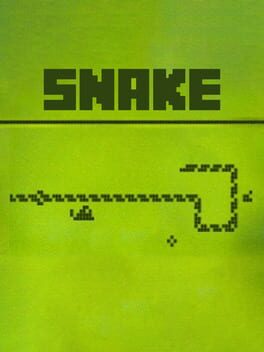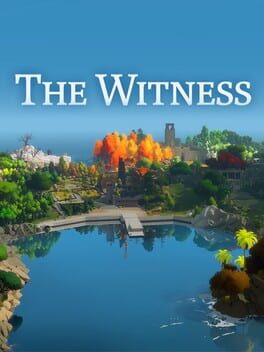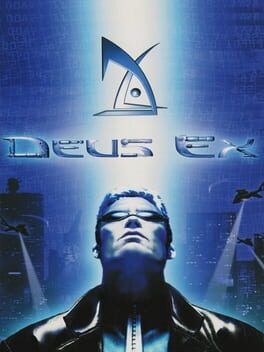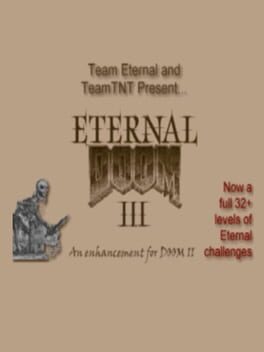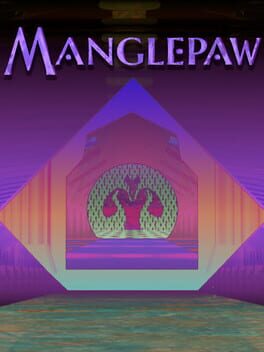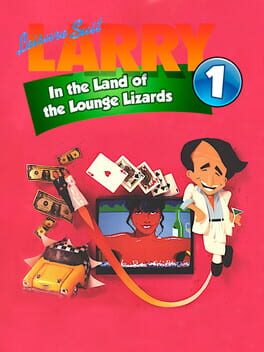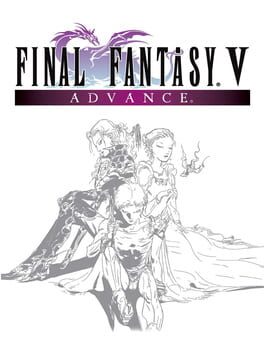Chwoka
Bio
Nothing here!
Badges

Gamer
Played 250+ games

Donor
Liked 50+ reviews / lists

Well Written
Gained 10+ likes on a single review

Popular
Gained 15+ followers

Liked
Gained 10+ total review likes

Roadtrip
Voted for at least 3 features on the roadmap

Best Friends
Become mutual friends with at least 3 others

Shreked
Found the secret ogre page

3 Years of Service
Being part of the Backloggd community for 3 years

GOTY '21
Participated in the 2021 Game of the Year Event

Noticed
Gained 3+ followers

N00b
Played 100+ games
Favorite Games
276
Total Games Played
000
Played in 2024
000
Games Backloggd
Recently Played See More
Recently Reviewed See More
Completely off on my own here but this game right here made middle-school me hate and fear RPGs and I still haven't shaken it off, honestly. I hit some kind of point where I believed I needed to grind to progress and it hit me like a punch in the stomach. Then I realized that I dreaded the prospect so much because I fundamentally and deeply hated the whole tedious menu-battling character-optimizing system that every battle was — that is, what I was dreading was having to suffer ANY MORE of the actual gameplay part of the game. Up to that point, I hadn't even thought if I was enjoying myself or not, just killing time. It's not like I was particularly invested in the story. It occurred to me that a quicker way to not have to do any more battles was just to stop playing, so I did, and wrote off the entire RPG genre.
From my blog, Arcade Idea
When Philo T. Farnsworth first demonstrated his all-electronic CRT television to anyone outside of the laboratory where it was invented, he said "here's something the bankers can understand" and turned it on to produce an image of a dollar bill. When Thomas T. Goldsmith was trying to come up with a way for the user to directly interface with the CRT for trifling amusement rather than a practical use-case, he made a game where you shoot down planes. These are eerie portents of the future — no, scratch that, full-on curses invoked that the respective mediums have not yet recovered from.
https://www.youtube.com/watch?v=FBgvS2OuFwI
Stan Kenton Orchestra (composer Bob Graettinger) - Thermopylae [1947]
Television and video games are, to my mind, siblings. They're cursed and compromised mediums, and art within it has to come to terms with the attendant formal inertia. They were born in the same wave of technological innovation. A console is functionally an extra TV channel. Artworks in both mediums often pointedly aspire to cinema, a tendency long-present but especially pronounced in the 21st century. This is in obvious compensation to the stench of disposable disrepute that dogs them. Both mediums are restlessly oriented towards the future, perhaps owing to their history of technological advance, and thus have a largely tenuous, fraught relationship with its own past, where nostalgia has had to balance against shame over how primitive, corny earlier works. So even as it tries to excite the audience about the next thing, it's constantly repeating itself in ways both small and large. Both have murky, obscure, protracted technical origins in laboratories decades before being ready for consumers, and then they ascend to being a dominant — arguably the dominant — mass medium of their time.
World War 2 put a serious damper on the entrance of television into mass popularity, but at the same time, the US government pumped a lot of money into the research and development of television technology for military purposes. The whole American television industry, which had never yet lived up to its own decades of hype and been able to profit by manufacturing and selling a real product to consumers in any substantial quantity, pivoted instead to the lucrative prospect of war grants. We all know about radar, but there were also dreams of infrared night-vision & sniper lasers, and of TV-guided precision missiles. This latter endeavor directly led to the creation of the image orthicon, which would become the very linchpin that made commercial television practical from 1945 to 1968, the "Immy" for which the Emmys are still named.
So when Goldsmith in the DuMont laboratory 2 years out from the war was trying to think of a fictional context for his Cathode Ray Tube Amusement Device [1947], it cannot really be considered surprising that his mind leapt to a combination between radar and the TV-guided missile. In CRT Amusement Device, the player adjusts a lobbing arc drawn across a radar-style circular screen from the bottom-left up and to the right, and they also get to brighten the beam at any point of their choosing within that arc. All interface is via dials. A transparent overlay is physically placed on the screen: images of planes that are targets for the player to hit. To make this task a challenge, there's a timer, entirely separate from the rest of the equipment. Despite being so simple, this immediately raises a number of questions. Firstly, is this a video game?
That's a tricky question, because here in 2022, we're still not totally sure what video games are. The progenitors of television knew their goal exactly and set out to make it happen. It's a bit strong to say that video games were conversely invented by accident, but it was a slow process of conceptual evolution that never really stopped. Roughly speaking, the world saw Pong [1972], came up with a phrase for "things like Pong", and then that phrase gradually stretched to include everything on this blog and much more. That's exactly what's interesting about these early, pre-commercial years: people are working out what video games are and what they're for for the first time with no preconceptions, and little-to-no knowledge of any predecessors in the field whatsoever. CRT Amusement Device, in my book, is definitely conceptually in-line with Pong: not only does it look and play a bit like Tennis For Two [1958] (also from DuMont's lab,) it manages with its "overlay" technology to bear an even stronger resemblance to the Magnavox Odyssey [1971] that inspired Pong, enough to eventually surface as a trump card against the legal claim on originating and rent-gathering on the Television Game concept.
There's a documentary on YouTube called "The First Video Game" that I sincerely recommend as an inventory and exploration of extremely early video games. However, I must respectfully disagree with its prescriptive approach, in particular its final criteria:
"A video game must:
1) Exist in a practical implementation
2) Generate some kind of video signal
3) Have interaction that alters this signal
4) Be principally intended for entertainment
5) Be playable solely through the video display(s)"
quibble with points 1, 2, 4, and 5, which means I reach different conclusions.
-- To point 2: Games like The Oregon Trail [1971] were originally developed for teletype machines with a printed display, did not change their very nature by transferring to monitor display, and there have been experimental audio-only games as well. The presence of the word video in "video game" is historical accident, not a determinant. "Computer games" or "digital games" would probably be more accurate, although one objection to CRT Amusement Device not covered in this list is that it's not running on a digital computer but an electronic series of wave generators and variable resistors, without even so much as a transistor, semiconductor, or memory. This is a fair point, but I don't think the underlying technicalities of construction makes a lot of difference to the end experience.
-- To point 5: Many games rely on external knowledge or input beyond the bounds of its visual display. Any game that requires mapping, or for you to read the manual, or, as in the case of the Magnavox Odyssey and CRT Amusement Device, for the player to impose external constraints on their own technologically-unlimited behavior. I think this item is principally intended to exclude electro-mechanical games like pinball machines and shooting galleries, which is fair because they rely on real-world unsimulated physics, even though the story of those games, their creators, and their social position so seamlessy leads into the story of arcade video games in the 1970s.
-- To point 4: There are video games not principally intended for entertainment.
-- Most interestingly, to point 1: What counts as a "practical implementation" in a medium that is largely digital? Sources are unclear if any CRT Amusement Device prototype ever physically existed or not, but either way that object doesn't exist now. What we're left with is the patent documentation, which are instructions sufficient to build our own replica if inclined. As covered in the post on Hamurabi [1968/1973], the "type-in" game was a common distribution method throughout the 70s where you would print the source code to the game on paper for the end-user to manually re-inscribe on their own machines like a monk. Indeed, any video game that isn't a hardwired unit really is fundamentally distributed as instructions for building itself.
This is the whole problem with defining things that are out there in the world, they're so easy to problematize with annoying exceptions and objections drawn from the ranks of things we would common-sensically include in the category. I could and maybe might quibble with point 3 some more, like when I get to the "kinetic novel," which are perhaps culturally video games despite being non-interactive. For now though, let's accept that a video game must respond to input from the player.
When I wrote about the Magnavox Odyssey two whole years ago, I compared it to shining a flashlight on a board game. A recent article by Doc Burford, on the art of how to be making your players give a fuck [2022], reminded me of this. Early on, it makes a point that a flashlight is interactive electronics: You press a button and the light turns on or off. So point 3 alone is clearly insufficient for thinking about video games. Marshall McLuhan made a similar point about lightbulbs in general in Understanding Media [1964], that they were a medium without content and with an effect. But you can assemble the lightbulbs into letters or make them flash in morse code, and now you have a whole semantic grammar as well as those original effects, and that's how McLuhan approaches into television. They sharply diverge from there. McLuhan tells us about that the medium is the message, above whatever its semantic content happens to be. Bruford tells us that without content, we don't really have a medium at all. A television with no content isn't television, it's a white noise generating appliance. (Arguably, much or all of the content on television does not move beyond this status.) Likewise, an interaction with a computer or other electronic device does not become a potential art medium until the player gives a fuck in their minds about the lights being on or off, usually by how that interweaves with other lights and your choice of on or off in a legible pattern. He specifically exempts Tetris [1984] from this, but surely for all its abstraction, Tetris is a language and you give a fuck how it's arranged.
CRT Amusement Device is barely more than a flashlight itself, or more accurately, an oscilloscope. Drawing an arc on the screen isn't a game. Drawing an arc on the screen that gets brighter at a particular point in the arc isn't a game. It's maybe a toy, or a tool if you can find a good use for an arc on the screen. It's the imagination that makes it a game. Games didn't have much in the way of storytelling before 1980, but they almost always had a premise. The timer just gives it friction. The earliest computer game I know of is actually Nimatron [1940], a Nim-playing computer. But I'm not interested in video games that just replicate older forms of games here, I'm specifically interested in games like this, games that explore original concepts for computer space. And this is the earliest attempt at that that I know of.
In the patent documentation itself, the player is simply hitting targets, and airplanes are just a sole example of what those targets might be. This is in contrast to the Magnavox Odyssey's passionate desperation to make its lights represent as many different things as they could think of, in many different play-styles. While the gameplay of CRT Amusement Device could be easily reskinned to not be airplanes, it wasn't, and it's not flexible like that. It's always target practice. It's always a World War 2 fantasy of radar and the guided missile, even if you pretended it was the spray from a hose, or needles into Bloons [2007].
Shooting targets has always had an insistent central prominence in video games, regardless of actual popularity and commercial success. It's got a gravitational pull. When the video games industry was called up before the United States congress for its own "vast wasteland" moment, it wasn't for low quality, it was for the worry that they were training the youth to be violent like at war but at home. Video games were born of war. Trajectories, competition, elimination, drilling over and over again to improve performance and self-discipline. That's not every video game, but it's never far away.
When Philo T. Farnsworth first demonstrated his all-electronic CRT television to anyone outside of the laboratory where it was invented, he said "here's something the bankers can understand" and turned it on to produce an image of a dollar bill. When Thomas T. Goldsmith was trying to come up with a way for the user to directly interface with the CRT for trifling amusement rather than a practical use-case, he made a game where you shoot down planes. These are eerie portents of the future — no, scratch that, full-on curses invoked that the respective mediums have not yet recovered from.
https://www.youtube.com/watch?v=FBgvS2OuFwI
Stan Kenton Orchestra (composer Bob Graettinger) - Thermopylae [1947]
Television and video games are, to my mind, siblings. They're cursed and compromised mediums, and art within it has to come to terms with the attendant formal inertia. They were born in the same wave of technological innovation. A console is functionally an extra TV channel. Artworks in both mediums often pointedly aspire to cinema, a tendency long-present but especially pronounced in the 21st century. This is in obvious compensation to the stench of disposable disrepute that dogs them. Both mediums are restlessly oriented towards the future, perhaps owing to their history of technological advance, and thus have a largely tenuous, fraught relationship with its own past, where nostalgia has had to balance against shame over how primitive, corny earlier works. So even as it tries to excite the audience about the next thing, it's constantly repeating itself in ways both small and large. Both have murky, obscure, protracted technical origins in laboratories decades before being ready for consumers, and then they ascend to being a dominant — arguably the dominant — mass medium of their time.
World War 2 put a serious damper on the entrance of television into mass popularity, but at the same time, the US government pumped a lot of money into the research and development of television technology for military purposes. The whole American television industry, which had never yet lived up to its own decades of hype and been able to profit by manufacturing and selling a real product to consumers in any substantial quantity, pivoted instead to the lucrative prospect of war grants. We all know about radar, but there were also dreams of infrared night-vision & sniper lasers, and of TV-guided precision missiles. This latter endeavor directly led to the creation of the image orthicon, which would become the very linchpin that made commercial television practical from 1945 to 1968, the "Immy" for which the Emmys are still named.
So when Goldsmith in the DuMont laboratory 2 years out from the war was trying to think of a fictional context for his Cathode Ray Tube Amusement Device [1947], it cannot really be considered surprising that his mind leapt to a combination between radar and the TV-guided missile. In CRT Amusement Device, the player adjusts a lobbing arc drawn across a radar-style circular screen from the bottom-left up and to the right, and they also get to brighten the beam at any point of their choosing within that arc. All interface is via dials. A transparent overlay is physically placed on the screen: images of planes that are targets for the player to hit. To make this task a challenge, there's a timer, entirely separate from the rest of the equipment. Despite being so simple, this immediately raises a number of questions. Firstly, is this a video game?
That's a tricky question, because here in 2022, we're still not totally sure what video games are. The progenitors of television knew their goal exactly and set out to make it happen. It's a bit strong to say that video games were conversely invented by accident, but it was a slow process of conceptual evolution that never really stopped. Roughly speaking, the world saw Pong [1972], came up with a phrase for "things like Pong", and then that phrase gradually stretched to include everything on this blog and much more. That's exactly what's interesting about these early, pre-commercial years: people are working out what video games are and what they're for for the first time with no preconceptions, and little-to-no knowledge of any predecessors in the field whatsoever. CRT Amusement Device, in my book, is definitely conceptually in-line with Pong: not only does it look and play a bit like Tennis For Two [1958] (also from DuMont's lab,) it manages with its "overlay" technology to bear an even stronger resemblance to the Magnavox Odyssey [1971] that inspired Pong, enough to eventually surface as a trump card against the legal claim on originating and rent-gathering on the Television Game concept.
There's a documentary on YouTube called "The First Video Game" that I sincerely recommend as an inventory and exploration of extremely early video games. However, I must respectfully disagree with its prescriptive approach, in particular its final criteria:
"A video game must:
1) Exist in a practical implementation
2) Generate some kind of video signal
3) Have interaction that alters this signal
4) Be principally intended for entertainment
5) Be playable solely through the video display(s)"
quibble with points 1, 2, 4, and 5, which means I reach different conclusions.
-- To point 2: Games like The Oregon Trail [1971] were originally developed for teletype machines with a printed display, did not change their very nature by transferring to monitor display, and there have been experimental audio-only games as well. The presence of the word video in "video game" is historical accident, not a determinant. "Computer games" or "digital games" would probably be more accurate, although one objection to CRT Amusement Device not covered in this list is that it's not running on a digital computer but an electronic series of wave generators and variable resistors, without even so much as a transistor, semiconductor, or memory. This is a fair point, but I don't think the underlying technicalities of construction makes a lot of difference to the end experience.
-- To point 5: Many games rely on external knowledge or input beyond the bounds of its visual display. Any game that requires mapping, or for you to read the manual, or, as in the case of the Magnavox Odyssey and CRT Amusement Device, for the player to impose external constraints on their own technologically-unlimited behavior. I think this item is principally intended to exclude electro-mechanical games like pinball machines and shooting galleries, which is fair because they rely on real-world unsimulated physics, even though the story of those games, their creators, and their social position so seamlessy leads into the story of arcade video games in the 1970s.
-- To point 4: There are video games not principally intended for entertainment.
-- Most interestingly, to point 1: What counts as a "practical implementation" in a medium that is largely digital? Sources are unclear if any CRT Amusement Device prototype ever physically existed or not, but either way that object doesn't exist now. What we're left with is the patent documentation, which are instructions sufficient to build our own replica if inclined. As covered in the post on Hamurabi [1968/1973], the "type-in" game was a common distribution method throughout the 70s where you would print the source code to the game on paper for the end-user to manually re-inscribe on their own machines like a monk. Indeed, any video game that isn't a hardwired unit really is fundamentally distributed as instructions for building itself.
This is the whole problem with defining things that are out there in the world, they're so easy to problematize with annoying exceptions and objections drawn from the ranks of things we would common-sensically include in the category. I could and maybe might quibble with point 3 some more, like when I get to the "kinetic novel," which are perhaps culturally video games despite being non-interactive. For now though, let's accept that a video game must respond to input from the player.
When I wrote about the Magnavox Odyssey two whole years ago, I compared it to shining a flashlight on a board game. A recent article by Doc Burford, on the art of how to be making your players give a fuck [2022], reminded me of this. Early on, it makes a point that a flashlight is interactive electronics: You press a button and the light turns on or off. So point 3 alone is clearly insufficient for thinking about video games. Marshall McLuhan made a similar point about lightbulbs in general in Understanding Media [1964], that they were a medium without content and with an effect. But you can assemble the lightbulbs into letters or make them flash in morse code, and now you have a whole semantic grammar as well as those original effects, and that's how McLuhan approaches into television. They sharply diverge from there. McLuhan tells us about that the medium is the message, above whatever its semantic content happens to be. Bruford tells us that without content, we don't really have a medium at all. A television with no content isn't television, it's a white noise generating appliance. (Arguably, much or all of the content on television does not move beyond this status.) Likewise, an interaction with a computer or other electronic device does not become a potential art medium until the player gives a fuck in their minds about the lights being on or off, usually by how that interweaves with other lights and your choice of on or off in a legible pattern. He specifically exempts Tetris [1984] from this, but surely for all its abstraction, Tetris is a language and you give a fuck how it's arranged.
CRT Amusement Device is barely more than a flashlight itself, or more accurately, an oscilloscope. Drawing an arc on the screen isn't a game. Drawing an arc on the screen that gets brighter at a particular point in the arc isn't a game. It's maybe a toy, or a tool if you can find a good use for an arc on the screen. It's the imagination that makes it a game. Games didn't have much in the way of storytelling before 1980, but they almost always had a premise. The timer just gives it friction. The earliest computer game I know of is actually Nimatron [1940], a Nim-playing computer. But I'm not interested in video games that just replicate older forms of games here, I'm specifically interested in games like this, games that explore original concepts for computer space. And this is the earliest attempt at that that I know of.
In the patent documentation itself, the player is simply hitting targets, and airplanes are just a sole example of what those targets might be. This is in contrast to the Magnavox Odyssey's passionate desperation to make its lights represent as many different things as they could think of, in many different play-styles. While the gameplay of CRT Amusement Device could be easily reskinned to not be airplanes, it wasn't, and it's not flexible like that. It's always target practice. It's always a World War 2 fantasy of radar and the guided missile, even if you pretended it was the spray from a hose, or needles into Bloons [2007].
Shooting targets has always had an insistent central prominence in video games, regardless of actual popularity and commercial success. It's got a gravitational pull. When the video games industry was called up before the United States congress for its own "vast wasteland" moment, it wasn't for low quality, it was for the worry that they were training the youth to be violent like at war but at home. Video games were born of war. Trajectories, competition, elimination, drilling over and over again to improve performance and self-discipline. That's not every video game, but it's never far away.
From my blog, Arcade Idea.
As wont as I am to call everything some kind of "adventure game", citing the enormous and cross-genre influence of Colossal Cave Adventure [1975/77], this is pointedly trying NOT to be an adventure game, for all its resemblance. You can tell, because it has an adventure game inside of itself, which exists to parody adventure games and thereby define how this game is something else on a parallel track. This parody is a maze to fumble around in, bumping into various generic fantasy creatures (elves, pixies, and whatnot) who all block your path further into the maze until you bring them the item that will satisfy their varied and peculiar demands. It's a anthropomorphication of the classic "lock-and-key" inventory-management puzzle solved through complete exploration of every nook and cranny of a convoluted space that we see all over the place. It's quite the stretch to call this business "puzzles" at all, despite customary lingo. The "puzzles," such as they are in your usual adventure game, are not actually that mechanism but the obscuring of that mechanism, the creation of ambiguity around which well-hidden key goes with which lock and how you are meant to turn it, but it's here delivered with barebones set dressing which may be charming and witty but which does nothing to obscure its simplistic functioning to the player, rendering itself as dumb brute force that only tests patience and persistence — which is something you very often see in the usual non-parodic adventure game, too. Other than in this parody, there is actually no inventory system in this game, despite it having the bog-standard adventure game premise of collecting 14 treasures.
---- MUSICAL INTERLUDE: LL Cool J - My Rhyme Ain't Done [1987] -----
Like Sokoban [1982] or Tetris [1984] or Chain Shot [1985] (aka SameGame), The Fool's Errand [1987] brings to my little ad-hoc canon of video games a whole new idea of what a "video game puzzle" even can be. Unlike those games, it doesn't just give us one great puzzle mechanic, it brings us dozens of bespoke minigames, such that it's structurally reminiscent of art games like The Prisoner [1980] or Lifespan [1983]. It gives to the history a whole philosophy and tradition from outside video games, mixed with its own novel concepts that could only be done in video games. It is a digital work inspired by those magazines full of brain teasers you see at supermarket checkout stands and their more sophisticated and upscale sibling, those analog gamebooks that give its puzzling some kind of overarching throughline and cohesion through things like a narrative scaffolding or a meta-puzzle or even a real-world treasure hunt. This idea will stick with video games (see: The 7th Guest [1993], Professor Layton and the Curious Village [2007]) but rarely, if ever, will it be done quite as well as it is here (see: The 7th Guest [1993].)
(This isn't a review, but that's showing my hand: this is flat-out one of the best games I've ever played, hasn't "aged" a day for as much as I resent that framing, and I heartily recommend you play it if you're reading this and it at all intrigues you. It's free from the original creator Cliff Johnson now and one of the easiest to get running that I've ever played for this blog. Also, there was no natural place to note it in the body of the text, so here in the praise aside: this has its visual aesthetics totally on lock and is one of the most strikingly gorgeous games ever made, certainly made by 1987. I know I say that about every Macintosh game I play but I really really mean it here. I believe, though I'm not sure, that the beautiful artwork may have been the handiwork of someone named Brad Parker.)
The remaining puzzles not coming from that storied paradigm, which I'll address first, are instead highly interface-reliant. The Macintosh the game was made for has a mouse, and in the 80s this is still a bold novelty to experiment with, reminiscent of the way Nintendo DS games could get very excited over ways to ask the player to use the touchscreen. The Fool's Errand will ask you to move your mouse in specific choreographed ways, or to scan your mouse over the screen, or to keep your mouse still. The puzzles in this category are actually either tests of physical performance or, like the good versions of the lock-and-key puzzles it parodies, actually a puzzle of figuring out through its ambiguity and obscurity what exactly you're meant to do and then is no puzzle at all after.
This philosophy also shores up the more traditional-seeming puzzles. Some of the rules to various puzzles are plainly stated to the player, but others are quite deliberately not. Instead, the player finds themself already digitally bound by these rules and sometimes must deduce what those restrictions even are through experimenting within the interface, in a way that could not be replicated in print. Sometimes the game doesn't even tell the player the ultimate goal to be working towards.
If "an adventure game is a crossword at war with a narrative," as Graham Nelson wrote in 1995, then in The Fool's Errand the crossword wins possibly too handily to qualify. Many, perhaps most, of this game's puzzles revolve around some form of wordplay. Not as in puns and rhymes and such, but things like anagrams and cyphers and word searches and literal crosswords which attune you not so much to the sense or sound of the words but call attention to the particulars of its actual constituent letters. Often, The Fool's Errand will provide you with mere nonsense that the narrative transparently and comically strains to manufacture a half-logical pretext for using in a sentence, or literal gibberish to which you are to subject the same rigors as the perfectly cromulent words that are mixed right in with it.
Which brings me to the game's regard towards text, a subject on which I'd be tempted to call it "agnostic" if it wasn't so darn gnostic. As indicated, it structurally doesn't care about the "meaning" of text, and I mean that in the extremely basic "See Spot Run" sense where to "interpret" or "comprehend" the text is to firstly process the concepts of things like "run" and "see", and then secondly to pay attention to how these concepts one by one connect and build on one another through grammar into something that makes sense, typically something with some nominal weight of real-life apprehension underpinning its semiotics somewhere. The Fool's Errand has long passages of witty prose that operate on the level of comprehensibility perfectly well. There's a narrative about a peace between the four kingdoms of the realm that, under pressure of famine and petty grievances and misunderstandings and magical schemes, is threatening to curdle right back into war unless The Fool can stop it through collecting treasures and counterspells. It just is rarely interested in the various kinds of textual interpretation afforded by that approach; it's there, I could readily perform a deeper exegesis of it, but it's not the one that is incentivized and prized.
This is one crucial thing separating the player and the Fool, who they are aligned with but certainly do not directly control nor embody: The Fool thinks his world is real and approaches it as such, taking the information he is given as if it is has some weight of fact behind it, and when it does not seem to have such a significance, that this is a failure or malfunction. Other characters say things to The Fool that only make sense to the player who has access to the actual game bits, and The Fool "gets weary of such confusing talk and [does] not wish to consider [it] at all," or conversely he'll seriously entertain the aforementioned strained justifications for using silly words. He misapprehends a giant symbolic totem which then has to explicitly tell him that it is a symbol and what it is a symbol for twice over before he recognizes the pattern. This may be the very thing that makes him a fool: He has no access to nor awareness of the true nature of his universe — maybe you can see now what I meant by "gnostic" — which is apparent to the reader as fictional, linguistically-constructed, gamified, and dense with symbolism.
The kind of reading The Fool's Errand is more invested in is a pseudo-esotericist one. The whole game is tarot-themed, with all of its characters and events and many of its items drawn from the tarot traditions. This cues the reader to not read its prose so literally. A layperson with only the vaguest knowledge of tarot still knows that when they see objects in a tarot context that that object is not to be understood as just plain-and-simple being that object. A sword isn't a sword, it's a metaphor for... something (the layperson won't know what,) and even part of its own system of metaphors parseable only by those who have trained to parse it. But The Fool's Errand, as best as I can tell, doesn't much leverage the traditional divinatory significance and readings of, say, The Empress, or the actual contents of any of The Book Of Thoth it invokes repeatedly. The Fool's Errand's usage of the things on tarot cards seems to be uniquely its own takes, self-contained, self-explaining as much as they need to be, and only lightly and occasionally informed by pre-existing tarot usage, such as The Fool himself being the wandering protagonist. And thank goodness, for my sake. I don't know much about tarot, and did just enough research hitting the books to realize it wouldn't be terribly relevant for properly reading nor playing this particular game. (Though then again, I can hardly be terribly confident in that conclusion. If you're more steeped in tarot than I, please play the game and tell me that I'm wrong in the comments section below!) Thank goodness for its sake, too. The game casts The High Priestess as an outright cackling villain to be defeated triumphantly, which would be quite thematically alarming and even bizarrely misogynist if she were meant to represent the mysterious half of femininity, but she's not used that way.
Its engagement with the symbols of tarot is ultimately similar to its engagement with the symbols that constitute the alphabet. While esotericist reading strategies are often posited as a way to get beyond surfaces and see a deeper reality than even the one we think we are familiar with, The Fool's Errand instead playfully focuses its attention right in on the surface, steadily devaluing the idea of even an knowingly-illusory reality effect. The narration is mostly a veiled pretense that, like the game's many anagrams, needs to be unjumbled and deciphered for information that can then be instrumentalized for the purpose of organizing a big sliding image tile puzzle and sorting syllables. It encourages the player to plunder its prose for encrypted data in search of not secret knowledge but secret treasure. The game and eventually the player is far more concerned with the deft interplay of these symbols qua symbols connecting and collecting within its own systems than the things the symbols usually gesture at.
Folks, we might have ourselves a hypertext here. It's borderline, but it's striking to me. Structurally, while there's no direct hyperlinks from one page to the next, the game's story is conceptualized as pages to be approached in arbitrary order. There is a final and proper canonical order, but filling in its gaps is itself a major overarching challenge. The classic logic of this-then-that narrative order and causality is invoked but obscured and its discovery is gamified. Pages are locked off by puzzle completion, and the pages you start with unlocked aren't all the first pages. Instead, the minigames pitch you hither and tither across the text, most often to the next page but just as likely clear into a different chapter. The narrative's been fragmented into episodic vignettes, and they often seemed to me to make just as much sense in that secondary order as in the primary order, like when I had a hard time with a puzzle and the next page unlocked began with The Fool also feeling exhausted from effort. You can read the last page right from the start, and the best straightforward explanation of what's going on and what you are to do is found in the similarly-available second-to-last chapter. Spiritually, there's also a distinct bent to the game where it's majorly concerned with connections and greedily gathering data points up, and delighted by the sheer architecture of its own semiotic house of mirrors, with only light concern if any for what it all adds up to or points at that ultimately makes it feel to me more "postmodern" (and hypertextual) than esotericist.
It's interesting just how much of a boom there is for node-based narrative here in the late 1980s. Partially that's an artifact of my selections, but I know for sure they're actually surprisingly sparse in the early 1980s. We've sadly seen the last Infocom game we're going to see on this blog already, but as the little-disputed critical and commercial leading light of text adventures recedes, we see not only the market but the texts themselves fragmenting — if you're even going to be considering this sort of thing as occupying the same aesthetic and niche that that sort of thing does as well at other times, which has become a fundamental guiding principle of the concept of "interactive fiction" but only as it was formulated through controversy. The parser norms of interactive fiction will reassert themselves in an Infocom-derived renaissance in the mid-90s, but then around the turn of the 2010s it zags back to hypertext again, possibly for good. Alternatively, if you see hypertext as something wholly separate from and even defined against the parser adventure game tradition, as The Fool's Errand suggests it to be, this was a savvy move from the parser camp to rhetorically capture and encompass a now-more-popular genre entirely within its own tradition. Either way, that makes this little interregnum feel like foreshadowing, all the moreso because a lot of these games are being made by people who come from backgrounds outside of gaming working solo or close to it who thereby have more offbeat perspectives and tones than the programmers we've been used to.
-------------
Thanks to Monkeysky for getting inspired to play the game at the same time as me so we could talk about it. Thanks to hypodronic for the recommendation of Lon Milo DuQuette's "Understanding Aleister Crowley's Thoth Tarot" — didn't bear much fruit for this article but did give me some sea legs.
As wont as I am to call everything some kind of "adventure game", citing the enormous and cross-genre influence of Colossal Cave Adventure [1975/77], this is pointedly trying NOT to be an adventure game, for all its resemblance. You can tell, because it has an adventure game inside of itself, which exists to parody adventure games and thereby define how this game is something else on a parallel track. This parody is a maze to fumble around in, bumping into various generic fantasy creatures (elves, pixies, and whatnot) who all block your path further into the maze until you bring them the item that will satisfy their varied and peculiar demands. It's a anthropomorphication of the classic "lock-and-key" inventory-management puzzle solved through complete exploration of every nook and cranny of a convoluted space that we see all over the place. It's quite the stretch to call this business "puzzles" at all, despite customary lingo. The "puzzles," such as they are in your usual adventure game, are not actually that mechanism but the obscuring of that mechanism, the creation of ambiguity around which well-hidden key goes with which lock and how you are meant to turn it, but it's here delivered with barebones set dressing which may be charming and witty but which does nothing to obscure its simplistic functioning to the player, rendering itself as dumb brute force that only tests patience and persistence — which is something you very often see in the usual non-parodic adventure game, too. Other than in this parody, there is actually no inventory system in this game, despite it having the bog-standard adventure game premise of collecting 14 treasures.
---- MUSICAL INTERLUDE: LL Cool J - My Rhyme Ain't Done [1987] -----
Like Sokoban [1982] or Tetris [1984] or Chain Shot [1985] (aka SameGame), The Fool's Errand [1987] brings to my little ad-hoc canon of video games a whole new idea of what a "video game puzzle" even can be. Unlike those games, it doesn't just give us one great puzzle mechanic, it brings us dozens of bespoke minigames, such that it's structurally reminiscent of art games like The Prisoner [1980] or Lifespan [1983]. It gives to the history a whole philosophy and tradition from outside video games, mixed with its own novel concepts that could only be done in video games. It is a digital work inspired by those magazines full of brain teasers you see at supermarket checkout stands and their more sophisticated and upscale sibling, those analog gamebooks that give its puzzling some kind of overarching throughline and cohesion through things like a narrative scaffolding or a meta-puzzle or even a real-world treasure hunt. This idea will stick with video games (see: The 7th Guest [1993], Professor Layton and the Curious Village [2007]) but rarely, if ever, will it be done quite as well as it is here (see: The 7th Guest [1993].)
(This isn't a review, but that's showing my hand: this is flat-out one of the best games I've ever played, hasn't "aged" a day for as much as I resent that framing, and I heartily recommend you play it if you're reading this and it at all intrigues you. It's free from the original creator Cliff Johnson now and one of the easiest to get running that I've ever played for this blog. Also, there was no natural place to note it in the body of the text, so here in the praise aside: this has its visual aesthetics totally on lock and is one of the most strikingly gorgeous games ever made, certainly made by 1987. I know I say that about every Macintosh game I play but I really really mean it here. I believe, though I'm not sure, that the beautiful artwork may have been the handiwork of someone named Brad Parker.)
The remaining puzzles not coming from that storied paradigm, which I'll address first, are instead highly interface-reliant. The Macintosh the game was made for has a mouse, and in the 80s this is still a bold novelty to experiment with, reminiscent of the way Nintendo DS games could get very excited over ways to ask the player to use the touchscreen. The Fool's Errand will ask you to move your mouse in specific choreographed ways, or to scan your mouse over the screen, or to keep your mouse still. The puzzles in this category are actually either tests of physical performance or, like the good versions of the lock-and-key puzzles it parodies, actually a puzzle of figuring out through its ambiguity and obscurity what exactly you're meant to do and then is no puzzle at all after.
This philosophy also shores up the more traditional-seeming puzzles. Some of the rules to various puzzles are plainly stated to the player, but others are quite deliberately not. Instead, the player finds themself already digitally bound by these rules and sometimes must deduce what those restrictions even are through experimenting within the interface, in a way that could not be replicated in print. Sometimes the game doesn't even tell the player the ultimate goal to be working towards.
If "an adventure game is a crossword at war with a narrative," as Graham Nelson wrote in 1995, then in The Fool's Errand the crossword wins possibly too handily to qualify. Many, perhaps most, of this game's puzzles revolve around some form of wordplay. Not as in puns and rhymes and such, but things like anagrams and cyphers and word searches and literal crosswords which attune you not so much to the sense or sound of the words but call attention to the particulars of its actual constituent letters. Often, The Fool's Errand will provide you with mere nonsense that the narrative transparently and comically strains to manufacture a half-logical pretext for using in a sentence, or literal gibberish to which you are to subject the same rigors as the perfectly cromulent words that are mixed right in with it.
Which brings me to the game's regard towards text, a subject on which I'd be tempted to call it "agnostic" if it wasn't so darn gnostic. As indicated, it structurally doesn't care about the "meaning" of text, and I mean that in the extremely basic "See Spot Run" sense where to "interpret" or "comprehend" the text is to firstly process the concepts of things like "run" and "see", and then secondly to pay attention to how these concepts one by one connect and build on one another through grammar into something that makes sense, typically something with some nominal weight of real-life apprehension underpinning its semiotics somewhere. The Fool's Errand has long passages of witty prose that operate on the level of comprehensibility perfectly well. There's a narrative about a peace between the four kingdoms of the realm that, under pressure of famine and petty grievances and misunderstandings and magical schemes, is threatening to curdle right back into war unless The Fool can stop it through collecting treasures and counterspells. It just is rarely interested in the various kinds of textual interpretation afforded by that approach; it's there, I could readily perform a deeper exegesis of it, but it's not the one that is incentivized and prized.
This is one crucial thing separating the player and the Fool, who they are aligned with but certainly do not directly control nor embody: The Fool thinks his world is real and approaches it as such, taking the information he is given as if it is has some weight of fact behind it, and when it does not seem to have such a significance, that this is a failure or malfunction. Other characters say things to The Fool that only make sense to the player who has access to the actual game bits, and The Fool "gets weary of such confusing talk and [does] not wish to consider [it] at all," or conversely he'll seriously entertain the aforementioned strained justifications for using silly words. He misapprehends a giant symbolic totem which then has to explicitly tell him that it is a symbol and what it is a symbol for twice over before he recognizes the pattern. This may be the very thing that makes him a fool: He has no access to nor awareness of the true nature of his universe — maybe you can see now what I meant by "gnostic" — which is apparent to the reader as fictional, linguistically-constructed, gamified, and dense with symbolism.
The kind of reading The Fool's Errand is more invested in is a pseudo-esotericist one. The whole game is tarot-themed, with all of its characters and events and many of its items drawn from the tarot traditions. This cues the reader to not read its prose so literally. A layperson with only the vaguest knowledge of tarot still knows that when they see objects in a tarot context that that object is not to be understood as just plain-and-simple being that object. A sword isn't a sword, it's a metaphor for... something (the layperson won't know what,) and even part of its own system of metaphors parseable only by those who have trained to parse it. But The Fool's Errand, as best as I can tell, doesn't much leverage the traditional divinatory significance and readings of, say, The Empress, or the actual contents of any of The Book Of Thoth it invokes repeatedly. The Fool's Errand's usage of the things on tarot cards seems to be uniquely its own takes, self-contained, self-explaining as much as they need to be, and only lightly and occasionally informed by pre-existing tarot usage, such as The Fool himself being the wandering protagonist. And thank goodness, for my sake. I don't know much about tarot, and did just enough research hitting the books to realize it wouldn't be terribly relevant for properly reading nor playing this particular game. (Though then again, I can hardly be terribly confident in that conclusion. If you're more steeped in tarot than I, please play the game and tell me that I'm wrong in the comments section below!) Thank goodness for its sake, too. The game casts The High Priestess as an outright cackling villain to be defeated triumphantly, which would be quite thematically alarming and even bizarrely misogynist if she were meant to represent the mysterious half of femininity, but she's not used that way.
Its engagement with the symbols of tarot is ultimately similar to its engagement with the symbols that constitute the alphabet. While esotericist reading strategies are often posited as a way to get beyond surfaces and see a deeper reality than even the one we think we are familiar with, The Fool's Errand instead playfully focuses its attention right in on the surface, steadily devaluing the idea of even an knowingly-illusory reality effect. The narration is mostly a veiled pretense that, like the game's many anagrams, needs to be unjumbled and deciphered for information that can then be instrumentalized for the purpose of organizing a big sliding image tile puzzle and sorting syllables. It encourages the player to plunder its prose for encrypted data in search of not secret knowledge but secret treasure. The game and eventually the player is far more concerned with the deft interplay of these symbols qua symbols connecting and collecting within its own systems than the things the symbols usually gesture at.
Folks, we might have ourselves a hypertext here. It's borderline, but it's striking to me. Structurally, while there's no direct hyperlinks from one page to the next, the game's story is conceptualized as pages to be approached in arbitrary order. There is a final and proper canonical order, but filling in its gaps is itself a major overarching challenge. The classic logic of this-then-that narrative order and causality is invoked but obscured and its discovery is gamified. Pages are locked off by puzzle completion, and the pages you start with unlocked aren't all the first pages. Instead, the minigames pitch you hither and tither across the text, most often to the next page but just as likely clear into a different chapter. The narrative's been fragmented into episodic vignettes, and they often seemed to me to make just as much sense in that secondary order as in the primary order, like when I had a hard time with a puzzle and the next page unlocked began with The Fool also feeling exhausted from effort. You can read the last page right from the start, and the best straightforward explanation of what's going on and what you are to do is found in the similarly-available second-to-last chapter. Spiritually, there's also a distinct bent to the game where it's majorly concerned with connections and greedily gathering data points up, and delighted by the sheer architecture of its own semiotic house of mirrors, with only light concern if any for what it all adds up to or points at that ultimately makes it feel to me more "postmodern" (and hypertextual) than esotericist.
It's interesting just how much of a boom there is for node-based narrative here in the late 1980s. Partially that's an artifact of my selections, but I know for sure they're actually surprisingly sparse in the early 1980s. We've sadly seen the last Infocom game we're going to see on this blog already, but as the little-disputed critical and commercial leading light of text adventures recedes, we see not only the market but the texts themselves fragmenting — if you're even going to be considering this sort of thing as occupying the same aesthetic and niche that that sort of thing does as well at other times, which has become a fundamental guiding principle of the concept of "interactive fiction" but only as it was formulated through controversy. The parser norms of interactive fiction will reassert themselves in an Infocom-derived renaissance in the mid-90s, but then around the turn of the 2010s it zags back to hypertext again, possibly for good. Alternatively, if you see hypertext as something wholly separate from and even defined against the parser adventure game tradition, as The Fool's Errand suggests it to be, this was a savvy move from the parser camp to rhetorically capture and encompass a now-more-popular genre entirely within its own tradition. Either way, that makes this little interregnum feel like foreshadowing, all the moreso because a lot of these games are being made by people who come from backgrounds outside of gaming working solo or close to it who thereby have more offbeat perspectives and tones than the programmers we've been used to.
-------------
Thanks to Monkeysky for getting inspired to play the game at the same time as me so we could talk about it. Thanks to hypodronic for the recommendation of Lon Milo DuQuette's "Understanding Aleister Crowley's Thoth Tarot" — didn't bear much fruit for this article but did give me some sea legs.
